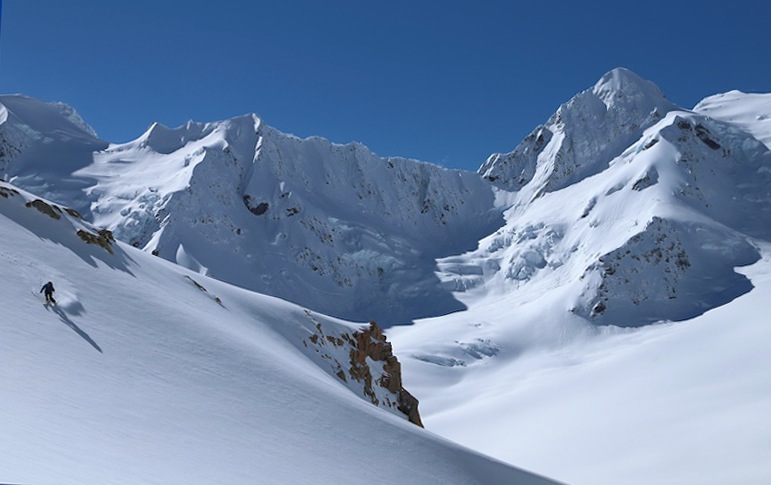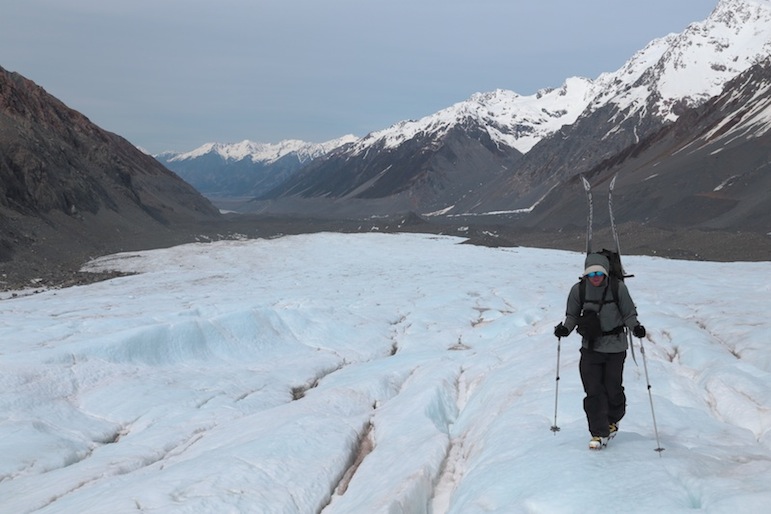Multi-day Ski Mountaineering: Tips from New Zealand

Story by Kate Hourihan
In early October, American skiers Nick Webb and Beau Fredlund met up in Christchurch to catch the tail end of the New Zealand winter. Arriving just after the ski resorts closed, and the flocks of winter tourists departed, they aimed to take advantage of the milder weather, longer days and more stable snow of the New Zealand spring. While the snow was still plentiful at high elevations, it was not easy to reach. And while they made several long day tours, Nick and Beau focused on multi-day trips to take advantage of the terrain above the long, tiring approaches. Their longest trip, totaling ten days, was spent exploring the upper Tasman Saddle in the Aoraki/Mt. Cook National Park. After walking two full days up the Tasman Glacier, they established a base-camp in a remote alpine area. In hearing their account, I was reminded of the organization required in preparing for such a trek. Here, they share with me some tips for planning and preparing for long ski mountaineering trips, whether in New Zealand or in your local mountain range.
Be flexible.
Weather and climbing conditions can change quickly, so have a plan that can adapt and evolve. For Nick and Beau, the idea to head to Aoraki/Mt. Cook National Park started out broadly. This park holds the majority of New Zealand’s highest peaks, making it an ideal destination for late-season ski mountaineering. Nick also explained, “Our objective for that particular trip was to get deep into the mountains and to be fully immersed in the landscape. Our previous trips were small and close to civilization and we were in the mood to go as far as we could get.”

Once in Cook Village, in a broad valley at the edge of the mountains, they began to narrow down their plan. Deciding exactly where to go, when and for how long was based on gathering forecast and route information. They spent a few days at the New Zealand Alpine Club Lodge talking to locals about snow and ice conditions and going over specific terrain features on their maps. They gleaned advice about which peaks in the area that might be suitable to climb and ski in good weather and where they might still be able to explore in less ideal conditions. Ultimately, they narrowed down their plan, waited for a decent weather window, and chose to head toward a central location on the upper Tasman Glacier that offered a diverse set of terrain to explore in multiple directions.
Know your gear.
Before their long walk up the Tasman, Nick and Beau spent a couple of weeks rattling around in a little Mitsubishi, taking in the New Zealand scenery and skiing when the conditions were good. They even did a few multi-day trips when they encountered good weather. Getting so many days out on snow early on was not only a fun way to see various places in New Zealand, but it put their gear through the wringer before they got too far from civilization.
No matter where you are skiing it’s a good idea to test and use all your gear as much as possible before you head out. Set up your tent. Test your stove. Replace batteries. Go for a long day tour and pay attention to crucial gear like bindings, skins and boots. If anything is about to break, you want to know about before you find yourself deep in the mountains.

But things can go wrong and even well-tested gear sometimes breaks, so still be prepared to fix it if it does. Or know how to live without it. Nick and Beau not only had the proper gear, but knew how to adapt and fix things on the fly. “For instance,” explained Nick, “if the tent pole broke, we would use the tent as a bivy sack for a night and high-tail it to the hut the next day. Or use a ski strap to fix it. I brought several ski straps and 10 meters of 3mm cord, which would fix just about any technical gear problem.”
Know your body.
Ski mountaineering is one of the more demanding activities you can put your body through. Being able to judge how many calories you anticipate burning per day and the best way to consume them is not easy. Nick claimed that making the most of pit-stops at the local “Four Square” grocery store was a critical piece of his backcountry experience. “Learning to accurately match the calories you burn with the amount of calories you are ingesting is essential,” explained Nick. So they loaded their packs with bars, and high calorie “goo” and dense, energy-rich food. This gave them tons of fuel without sacrificing too much pack space.
Similarly, you want to have a pretty good idea how much fuel you will go through. Anticipating how many warm meals per day you want to consume, plus how much snow you’ll need to melt for drinking water means doing some research. This can depend on your altitude, type of stove and how much you’ll use it. Taking some time to assess what your food, water and fuel consumption looks like will help you make sure you have enough.
Hope for the best, but prepare for the worst.
On a trip this long it is nearly impossible to know what the weather will do the whole time. Nick and Beau knew they’d have a few good-weather days to get to a spot up high where they could wait out a storm. And they were lucky to be within a day’s reach of a hut during most of their time high on the glacier. In Aoraki/Mt. Cook National Park this meant access to a radio and a retreat from the brutal winds typical of the area.
And during their 10 day trip on the Tasman Glacier they experienced a fairly significant storm that forced them to retreat to the Kelman hut for three days while they waited for the weather to break. But they also had several good days which allowed them to explore, climb and ski. They skied from the summit of Mt. Elie de Beaumont before the storm hit and when conditions were stable. And after the storm they were treated to new snow and good skiing in lower angle, protected terrain. The success of their good-weather days was dependent on knowing how to deal with bad weather and being patient enough to wait it out.
There is quite a lot more that goes into organizing a long trip like this. Details like having technical climbing and glacier travel gear, a first-aid kit, proper training, etc. are just as important. But even if you are well-trained and decked out with the latest gear, there are still subtleties that you can only learn from lots of experience in the mountains and careful planning.
